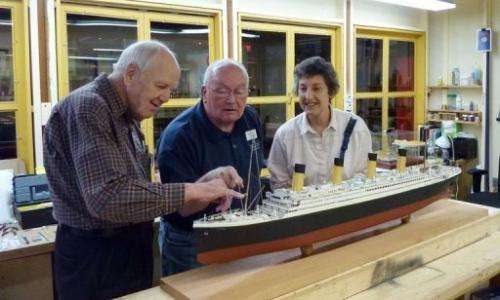Bacteria 'munching' on Titanic: scientists

In less than 30 years, there may be nothing left of the Titanic but a heap of "rusticles," warns researcher Henrietta Mann, who has spent four years researching bacteria gnawing on its sunken hull.
A scientific expedition in 1991 to the disintegrating wreck some 12,400 feet (3,780 meters) to the ocean floor revealed the formation of rust similar to icicles or stalactites in appearance hanging off the massive ship. They normally occur underwater when wrought iron oxidizes.
Mann, a biologist and geologist at Dalhousie University in Halifax, obtained samples from the Bedford Institute of Oceanography and scrutinized them under an electronic microscope. She discovered that bacteria, not a chemical process, were behind these particular deep water formations.
The Canadian researcher identified dozens of bacteria, including one never seen before, which she dubbed Halomonas Titanicae, that had been "munching" on the steel hull and busily transforming it, atom by atom, into rusticles, some as tall as men.
Invisible to the naked eye, measuring only 1.6 micrometers in length, the bacteria have multiplied into billions over the years.
"The Titanic is 50,000 tons of steel," Mann told AFP. "So, there is plenty of food for my bacteria."
The bacteria also appear to find delicious the ship's windows, stairways, and gates -- all made of rough iron -- as well as its cast iron furnaces. "They eat these as well," Mann said. Only the brass is not being touched.
"I don't know the speed of eating of the iron by the bacteria," but comparing the earliest photos of the wreck with the latest it is clear that rapid change is occurring.
"Maybe in 20 or 30 years the wreck will collapse (into a) heap of rust," she said.
Mann recorded 27 bacteria living in the rusticles, some with tentacles, as well as tube worms and other tiny creatures, in a "symbiotic colony."
The first of them were likely created by diatom (unicellular algae) in "marine snow" -- dirt from the surface. One bacteria then produced others and together they formed a chain and then a net, more bacteria grew over the net and holes filled in and finally the structures hardened into rusticles with channels inside where water circulates. "Its structure is like a sponge," Mann explained.
The disintegration of the Titanic would certainly mean a tremendous loss of heritage, says Mann. But at the same time her discovery offers hope: all of the old ships, oil rigs and cargo that fall to the bottom of the sea will not pile up like garbage.
Bacteria will eventually dispose of it all.
(c) 2012 AFP



















